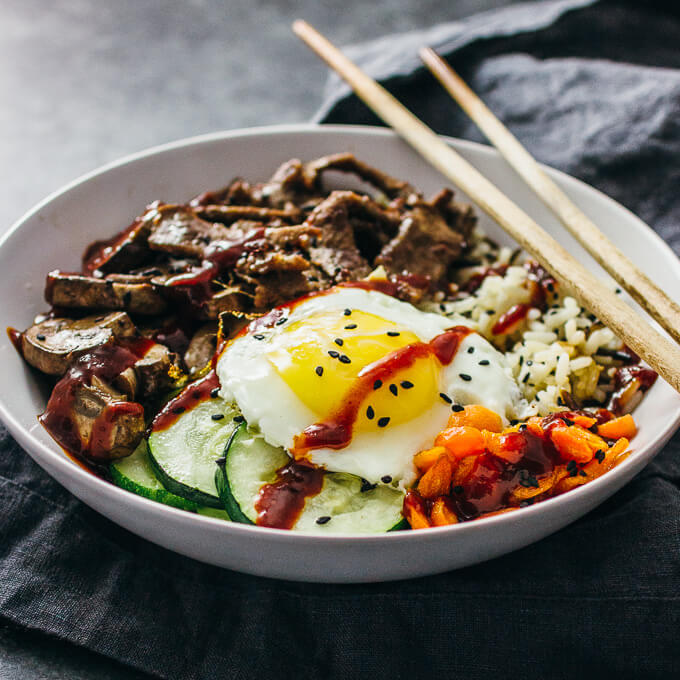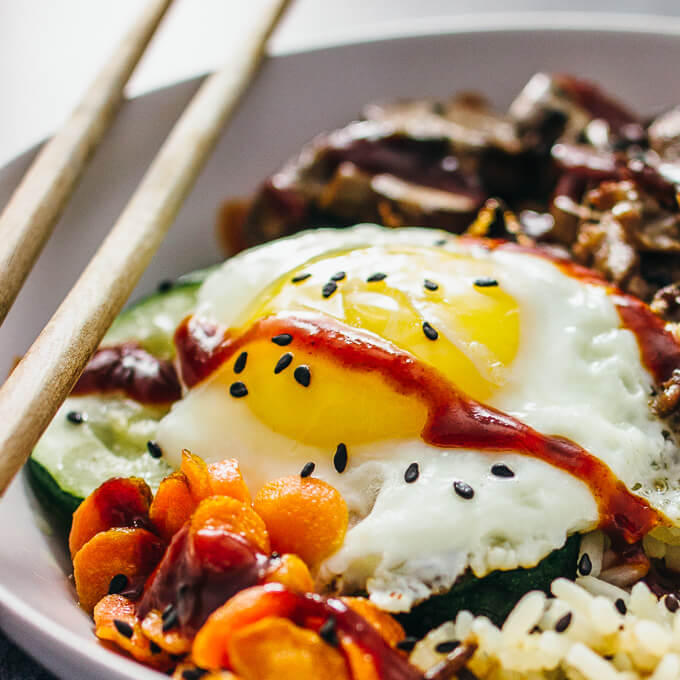It was about a decade ago when I first tried bibimbap. It was a comically huge bowl of pan-seared vegetables, steamed rice, marinated meat, a somewhat raw egg, and lots of spicy sauce, served in one of those general Asian restaurants that seem to offer all possible kinds of Asian food (Chinese, Korean, Japanese, Thai, you name it!). I was skeptical at first, but I was immediately won over by all of the textures and flavors, and of course, its unique hot sauce. Since then, I’ve always ordered bibimbap whenever I found myself in a Korean eatery. There are a lot of variations on bibimbap — after all, this dish or variants of it has been around for centuries — and this recipe is my rendition with my favorite bibimbap ingredients.




Bibimbap is one of those dishes that can help simplify your cooking life. Let me explain:
- You can easily make a big batch of bibimbap. Since you’re going to need to cook all of the vegetable and meat toppings, it’s just as easy to cook larger volumes of them and make a week’s worth of meals. Bibimbap bowls make for delicious and envious lunches that you can bring to work, and they reheat well in the microwave.
- You can use any raw or cooked leftover vegetable sitting in your refrigerator. Bibimbap goes well with almost any vegetable and this is a great way to clean out and deliciously repurpose your leftovers. Great ideas include cucumber, zucchini, carrots, mushrooms, spinach, lettuce, tofu, and sprouts. Even the beef can be substituted with chicken or seafood.

Let’s talk about the bibimbap sauce. Traditionally, gochujang is used, which is a thick Korean chili sauce made using red chilis and fermented soybeans. It’s a staple in Korean cooking and has a very distinct taste that makes bibimbap unique. You can find gochujang online or in specialty stores. If you’re wondering what else you can use gochujang for, I have plenty of ideas for you — it can work splendidly as a meat marinade, a glaze for chicken wings, a spicy dipping sauce, or as a tofu stir-fry sauce. If you don’t have gochujang, the next best thing to use is a mixture of sriracha and soy sauce.
Ingredients
- 1 cup uncooked white rice
- 10 ounces mushrooms, sliced
- 5 ounces carrots, sliced
- 1 zucchini, sliced
- 3 eggs
- 3 tablespoons gochujang
- 3/4 teaspoon black sesame seeds
- 3/4 pound flank steak, thinly sliced
- 2 tablespoons soy sauce
- 1 tablespoon corn starch
For the steak marinade:
Instructions
- Make the marinade: Rub corn starch onto sliced flank steak in a bowl. Drizzle soy sauce over the steak. Let sit in the refrigerator for at least 30 minutes.
- Cook the rice: Cook rice according to package instructions. Distribute the rice among 3 serving bowls.
- Cook the toppings: Heat a pan over medium heat until hot, a few minutes. Cook each of the vegetable toppings in turn, until they just start to become tender, about 8 minutes for the carrots, 5 minutes for the mushrooms, and 5 minutes for the zucchini. Sear the steak until no longer pink, about 3 minutes. Fry the eggs on one side until the whites are firm but the yolks are still liquid.
- Assemble the bowls: Distribute the toppings among the serving bowls with rice. Drizzle gochujang over the serving bowls. Sprinkle with black sesame seeds. Serve immediately.

http://www.savorytooth.com/bibimbap/